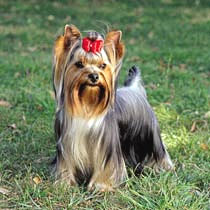|
The Canine Chronicles Directory
Yorkshire Terrier

Yorkshire Terriers are a small sturdy breed. The flat head is held high with a medium
length muzzle. The black eyes are round, bright, with dark rims and the nose black.
The ears are small, triangular, erect and covered with dark hair. The coat is long
parting in the middle and falling to the ground on either side of the dog. The texture
of the hair is similar to human hair which is helpful to people with allergies.
The hair should be a golden color; darker at the roots and lighter towards the feet.
Black, blue or "skunk"-like marks are not acceptable when showing this breed. The
legs should be solid and straight. The tail can be docked but shouldn't be too short.
|
|
Temperament
|
Yorkshire Terriers are small dogs but they have big attitudes. They are very warm
and affectionate with their owners but can also be ferocious when its territory
is being invaded. Although Yorkshire Terriers are not naturally good around children,
if brought up with children or socialized with them at a young age, this breed will
do well. Children also need to understand that this breed is small, delicate and
will become defensive if played with roughly.
|
|
Height, Weight
|
Height: 6-7" ; Weight: 7 lbs.
|
|
Health Problems
|
This breed is prone to early tooth decay, bronchitis and having a delicate digestive
tract. Some have a poor tolerance for anesthesia. This breed is also prone to fractures
of their tiny bones. Females may have trouble delivering. Make sure your Yorkie
eats some dry dog food to help keep their teeth strong and clean. Have their teeth
cleaned regularly by a Vet.
|
|
Living Conditions
|
The Yorkie will do great living in an apartment as they are very active indoors.
There is no need for a yard. They prefer warmer climates.
|
|
Exercise
|
This breed is always ready for a walk, but are not fussy about how much exercise
they require. They will stay healthier with regular exercise.
|
|
Life Expectancy
|
About 12-15 years
|
|
Grooming
|
The breed's coat needs regular grooming. The topknot is usually tied back. Clip
the coat when needed and brush and comb weekly. Show dogs require hours of grooming.
Have this breed's teeth cleaned regularly.
|
|
Origin
|
The origin of the Yorkshire terrier is told through two different stories; the true
story is still unknown. The first story states: An immigration occurred in the 1850s,
from Scotland to Yorkshire and Lancashire (England). Scottish weavers brought with
them Scotch Terriers (also known as Halifax Terriers). These terriers were bred
with the Manchester Terrier, the Maltese, the Skye, Dandie Dinmont and the Paisley
terriers. The second story states: In the 1800s English miners wanted to breed a
dog that would help control rat populations in the mine shafts. They cross-bred
the Dandie Dinmont, Skye Terrier, black and tan toy terrier and the Maltese which
resulted in the Scotch Terrier. They were baited with rats for the amusement of
miners. Years later the Yorkshire Terrier became a favorite among wealthy women
who carried them as an accessory in their handbags or under their arms. This breed
was first shown as the Scotch Terrier in 1861 and the name was eventually changed
to Yorkshire Terrier. The breed was officially recognized by the Kennel Club in
1886 and soon after was imported to the United States. They were originally considered
a breed for the "working class" and were used primarily as a ratter. Popular belief
states that Yorkshire Terriers were placed at the end and foot of children's beds
to keep them safe from rats during the night. They are recognized by the AKC and
the UKC.
|
|
Group
|
AKC Toy, UKC Companion Dog
|